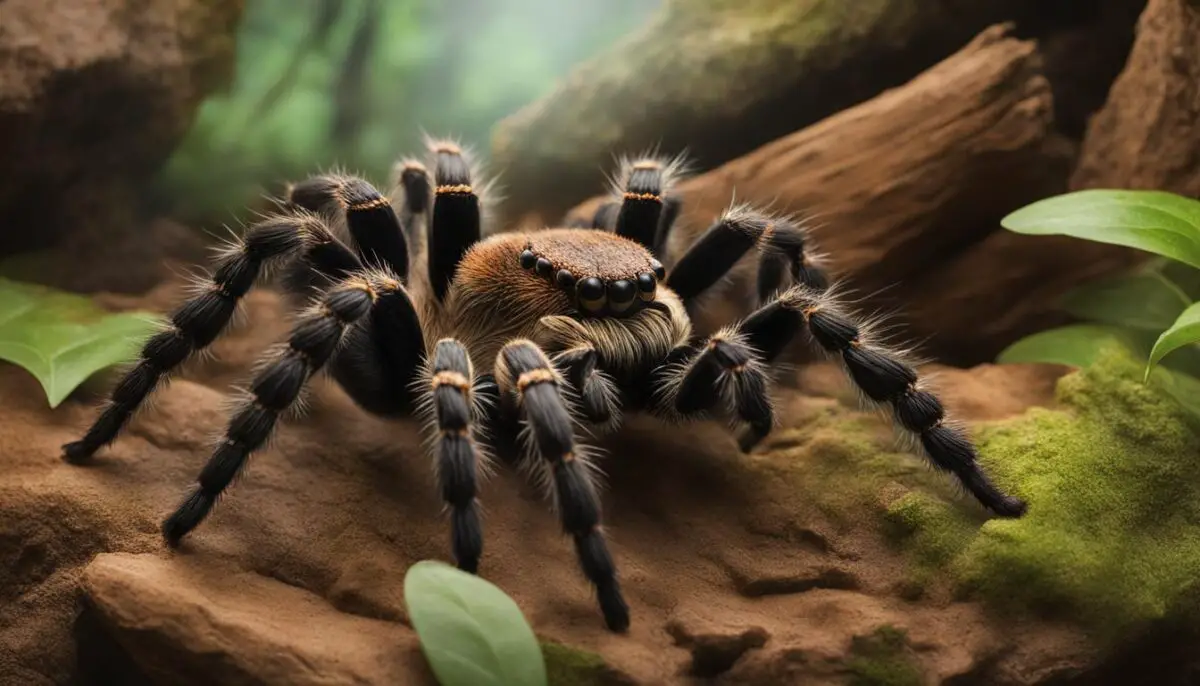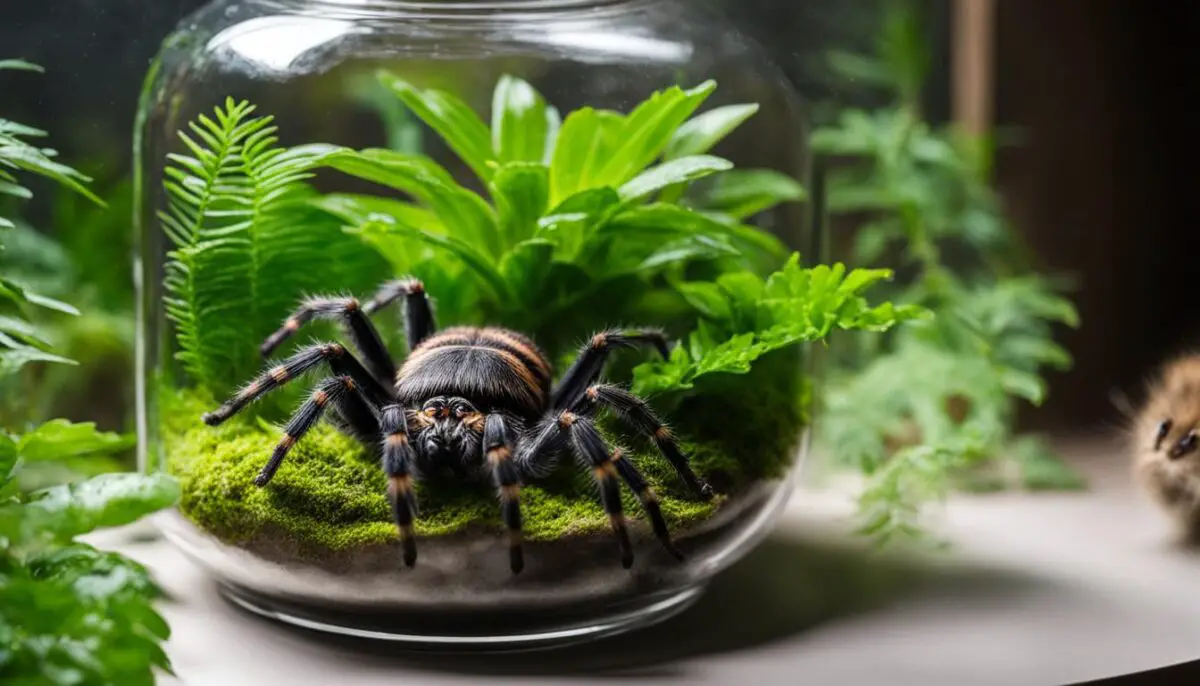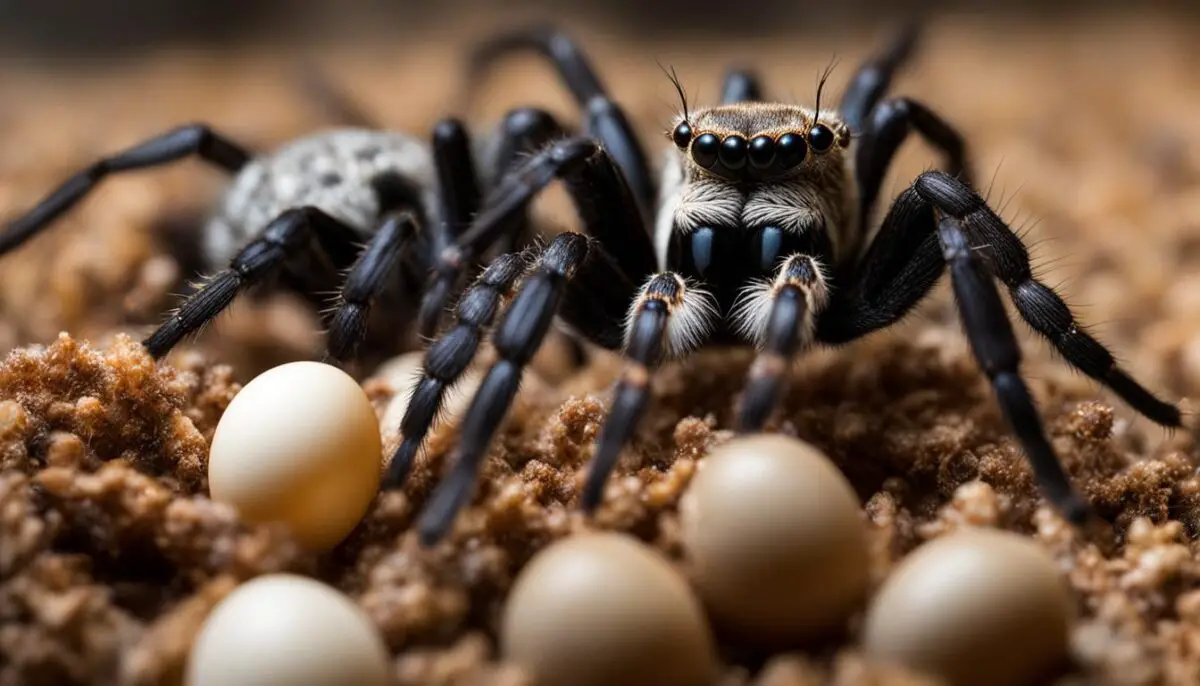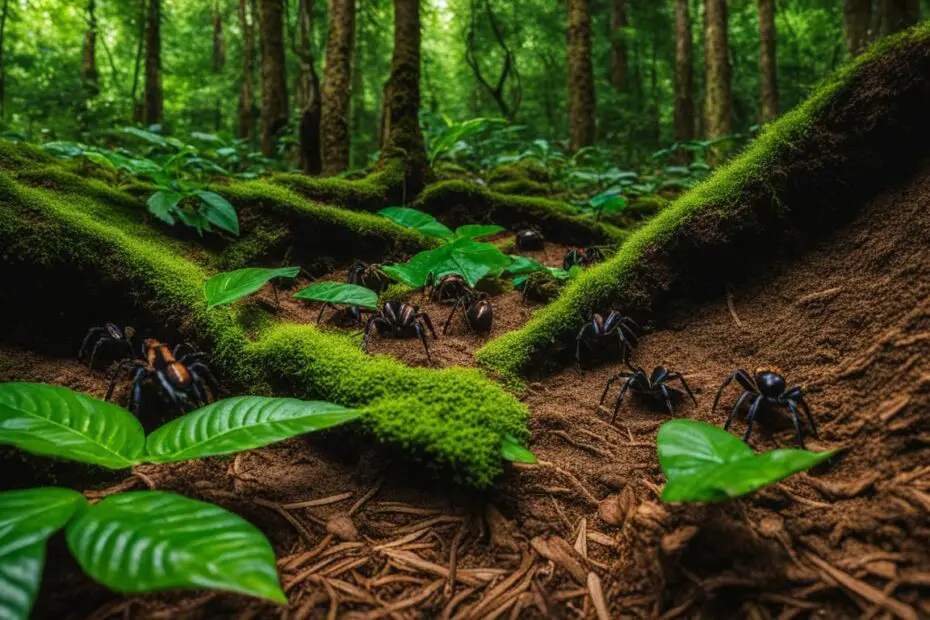Tarantulas have a unique lifecycle that determines when they live and thrive. Understanding the factors that affect their lifespan and habitat can provide valuable insights into their behavior and care. Let’s explore the fascinating world of tarantulas and shed light on when they live.
Key Takeaways:
- Tarantulas have a distinct life cycle that includes stages such as eggs, spiderlings, juveniles, and adults.
- They can thrive in diverse habitats like forests, deserts, and grasslands, but their specific needs vary depending on the species.
- Tarantulas exhibit unique behaviors, such as being primarily nocturnal and displaying defensive mechanisms when threatened.
- There are over 900 known species of tarantulas, each with its own characteristics and behaviors.
- Proper care and maintenance are essential for the health and well-being of pet tarantulas, including providing suitable enclosures and monitoring their behavior.
When Tarantulas Live
The Lifecycle of Tarantulas
Tarantulas go through several distinct stages in their life cycle. They start as eggs, which hatch into spiderlings. Spiderlings then grow into juveniles, and eventually mature into adult tarantulas. The length of each stage can vary depending on the species and environmental conditions. By understanding the different phases of the tarantula life cycle, we can gain insights into their growth and development. tarantula lifespan
| Life Stage | Description | Duration |
|---|---|---|
| Egg | The life of a tarantula begins as an egg laid by the female. The eggs are often stored in an egg sac, which the female guards and protects. | Variable, typically a few weeks |
| Spiderling | When the eggs hatch, tiny spiderlings emerge. At this stage, they are vulnerable and require care from their mother or specialized care from breeders. | Several weeks to a few months |
| Juvenile | As spiderlings grow, they molt, shedding their exoskeleton to accommodate their growth. The juvenile stage is crucial for development, and tarantulas often show distinct color changes as they mature. | Several months to a couple of years |
| Adult | Adult tarantulas have reached full maturity and are capable of reproducing. The duration of the adult stage varies significantly among species, ranging from a few years to several decades. | Variable, depending on the species |
During each stage of the tarantula life cycle, the spider’s nutritional needs, behavior, and habitat preferences may differ. It is essential for tarantula owners to understand these differences to provide optimal care and support their tarantula’s overall well-being. life cycle of tarantulas
Tarantula Molting
Molting is a significant event in the tarantula life cycle. It is the process of shedding the old exoskeleton to allow for growth and development. Before molting, tarantulas often exhibit changes in behavior and appearance. They may become less active, refuse food, and develop a darkened coloration. tarantula behavior
During the molting process, tarantulas create a secure space by spinning a thick web. This web provides support and protection as the tarantula sheds its old exoskeleton. It is crucial for tarantula owners to provide a stress-free environment during this period and avoid disturbing the molting tarantula.
Molting can be a vulnerable time for tarantulas, and proper care is essential to ensure their safety and well-being. By understanding the molting process and providing the necessary conditions, tarantula owners can support their spiders through this natural and fascinating stage of their life cycle.
Habitat of Tarantulas
Tarantulas are fascinating creatures that can be found in a variety of habitats around the world. These habitats can range from lush forests to arid deserts and even open grasslands. Each species of tarantula has specific habitat preferences that allow them to thrive in their natural environment.
One key aspect of tarantula habitat is the presence of suitable shelters. Tarantulas typically build burrows or create retreats in natural crevices to protect themselves from predators and extreme weather conditions. These shelters provide a secure space for the tarantulas to rest, molt, and lay eggs.
Another important factor in tarantula habitat is the availability of food. Tarantulas are carnivorous creatures that primarily feed on insects and other small invertebrates. Their habitats must have an abundant supply of prey to ensure their survival and well-being.
| Tarantula Species | Habitat |
|---|---|
| Brazilian Black Tarantula (Grammostola pulchra) | Found in the rainforests of Brazil, these tarantulas prefer warm and humid environments. |
| Mexican Red Knee Tarantula (Brachypelma smithi) | Native to Mexico, these tarantulas inhabit scrublands and grassy areas. |
| Greenbottle Blue Tarantula (Chromatopelma cyaneopubescens) | Originally from Venezuela, these tarantulas thrive in tropical rainforests. |
It’s important to recreate these habitat conditions as closely as possible when keeping tarantulas in captivity. This includes providing the appropriate temperature, humidity, and substrate in their enclosures. By mimicking their natural habitat, tarantulas can thrive and exhibit their natural behaviors even in a captive setting.
Creating a suitable habitat is essential for the well-being of tarantulas. By understanding their habitat preferences and providing the necessary conditions, tarantula owners can ensure their pets lead healthy and fulfilling lives.

Behavior of Tarantulas
Tarantulas are fascinating creatures that exhibit unique behaviors both in the wild and in captivity. Understanding their behavior is essential for providing the best care and creating a stress-free environment for these remarkable arachnids.
In the wild, tarantulas are primarily nocturnal, which means they are most active during the night. They spend their nights hunting for prey and exploring their surroundings. During the day, they typically retreat to their burrows or hide in natural crevices to protect themselves from predators and extreme weather conditions.
When threatened, tarantulas can display defensive behaviors. One common behavior is raising their front legs as a warning. They may also flick urticating hairs from their abdomen, which can irritate the skin or eyes of potential predators. These behaviors serve as a deterrent and help tarantulas defend themselves.
In captivity, tarantulas may exhibit different behaviors depending on their species and individual personalities. Some tarantulas may become accustomed to their owners and show signs of recognition, while others may remain more aloof. It is important to provide a quiet and undisturbed environment for captive tarantulas to minimize stress and allow them to exhibit their natural behaviors.
Quotes:
“Tarantulas are fascinating creatures that exhibit unique behaviors both in the wild and in captivity.”
“Understanding their behavior is essential for providing the best care and creating a stress-free environment for these remarkable arachnids.”
Observing the behavior of tarantulas can provide valuable insights into their needs and preferences. By creating a suitable environment and respecting their natural behaviors, tarantula owners can establish a bond of trust and ensure the well-being of their fascinating pets.
Different Tarantula Species
Tarantulas are a diverse group of spiders, with over 900 known species. Each species has its own unique characteristics, habitat preferences, and behaviors. Let’s take a closer look at some popular tarantula species:
Brazilian Black Tarantula (Grammostola pulchra)
The Brazilian Black Tarantula is a stunning species known for its dark, velvety appearance. It is native to Brazil and is often kept as a pet due to its docile nature. This species prefers a humid environment and can live for up to 20 years in captivity.
Mexican Red Knee Tarantula (Brachypelma smithi)
The Mexican Red Knee Tarantula is one of the most iconic tarantula species. It is known for its vibrant red-orange coloration on its knees and abdomen. This species is found in Mexico and requires a warm and dry habitat. With proper care, it can live for over 20 years.
Greenbottle Blue Tarantula (Chromatopelma cyaneopubescens)
The Greenbottle Blue Tarantula is a striking species native to Venezuela. It is known for its metallic blue legs and vibrant orange abdomen. This tarantula species is arboreal and requires a tall enclosure with plenty of climbing opportunities. With proper care, it can live for 10 to 15 years.
| Tarantula Species | Habitat | Lifespan |
|---|---|---|
| Brazilian Black Tarantula | Forest floor | Up to 20 years |
| Mexican Red Knee Tarantula | Desert scrubland | Over 20 years |
| Greenbottle Blue Tarantula | Venezuelan rainforest | 10 to 15 years |
These are just a few examples of the incredible diversity among tarantula species. Each species has its own unique beauty and requirements, making them fascinating creatures to observe and care for.
Tarantula Care and Maintenance
Proper care and maintenance are essential for ensuring the health and well-being of pet tarantulas. By providing a suitable enclosure, appropriate temperature and humidity levels, and a balanced diet of live prey, tarantula owners can create an optimal environment for their pets to thrive. Regular monitoring of the tarantula’s health, cleaning of the enclosure, and observation of their behavior are also crucial aspects of their care.
When it comes to housing, tarantulas require an enclosure that replicates their natural habitat. This typically includes a well-ventilated enclosure with enough space for the tarantula to move around comfortably. The substrate should be appropriate for burrowing, and hiding spots should be provided to mimic their natural retreats. It’s important to research the specific needs of your tarantula species to ensure the enclosure meets their requirements.
Temperature and humidity play a vital role in the overall well-being of tarantulas. Different species have different temperature preferences, but most tarantulas thrive in a temperature range of 70-80°F (21-27°C). Humidity levels should be maintained between 60-70%, although this can vary depending on the species. Monitoring these parameters using a digital thermometer and hygrometer is crucial to ensure a stable and suitable environment for your tarantula.
Feeding tarantulas a balanced diet is essential for their growth and overall health. Tarantulas are carnivorous and primarily feed on live prey, such as crickets, mealworms, and roaches. The size of the prey should be appropriate for the tarantula’s size, and feeding schedules may vary depending on the species and age of the tarantula. It’s important to observe their feeding behavior and adjust the frequency and quantity of food accordingly.

Table: Tarantula Care Guidelines
| Aspect of Care | Guidelines |
|---|---|
| Housing | Provide a well-ventilated enclosure with appropriate substrate and hiding spots. |
| Temperature | Maintain a temperature range of 70-80°F (21-27°C) in the tarantula’s enclosure. |
| Humidity | Maintain humidity levels between 60-70% in the tarantula’s enclosure. |
| Feeding | Feed tarantulas a balanced diet of live prey appropriate for their size. |
| Health Monitoring | Regularly observe the tarantula’s behavior and check for any signs of illness or stress. |
| Cleaning | Keep the tarantula’s enclosure clean by removing any uneaten prey and waste. |
By following these care guidelines, tarantula owners can ensure that their pets live long and healthy lives. Remember to always do thorough research on the specific needs of your tarantula species and consult with experts or experienced tarantula owners if you have any questions or concerns. With proper care and attention, tarantulas can be fascinating and rewarding pets to have.
Tarantula Molting
Tarantula molting is a natural process where these fascinating creatures shed their exoskeletons to facilitate growth and development. It is an essential part of their life cycle and a key indicator of their health and well-being. During this period, tarantulas undergo remarkable transformations that offer a unique glimpse into their biology.
Different species of tarantulas have varying molting patterns and frequencies. Generally, the molting process begins with a decrease in activity as the tarantula prepares for the upcoming molt. They may refuse food and display a darkened coloration, indicating that molting is imminent. At this stage, it is crucial to provide a safe and stress-free environment for the molting tarantula.
During the molt, tarantulas create a secure space by spinning a thick web around themselves, protecting their soft and vulnerable new exoskeleton. The actual molting process can take several hours to a few days, during which the tarantula slowly sheds its old exoskeleton and emerges as a larger and more vibrant individual. It is important to avoid disturbing the tarantula during this critical stage, as any disruption could cause potential harm.

Table: Tarantula Breeding Checklist
| Step | Explanation |
|---|---|
| Research | Gather information on the specific breed of tarantulas you intend to breed and their unique breeding requirements. |
| Create the Right Environment | Adjust the temperature and humidity levels in the enclosure to simulate the tarantulas’ natural habitat. |
| Introduce the Mating Pair | Place the male and female tarantulas together in a neutral environment and monitor their interactions closely. |
| Observe Courtship Behaviors | Watch for courtship behaviors displayed by the male tarantula, such as drumming or dancing, and receptive behaviors from the female. |
| Provide a Suitable Laying Substrate | Prepare a suitable substrate for the female tarantula to lay her eggs, ensuring it provides the right amount of moisture and support. |
| Monitor the Egg Sac | Regularly check the egg sac for signs of development and ensure the female is undisturbed during this critical stage. |
By following the necessary precautions and providing the appropriate conditions, tarantula breeding can be a rewarding experience for enthusiasts. It offers the opportunity to contribute to the conservation of these fascinating creatures and gain a deeper understanding of their lifecycle and behavior.
Tarantula Predators
Tarantulas, despite their intimidating size and appearance, have natural predators in the wild. These predators play an important role in maintaining the ecological balance of their habitats. Some of the most common predators of tarantulas include:
- Birds: Certain bird species, such as cuckoos and roadrunners, are known to feed on tarantulas. They are able to detect and capture these spiders with their sharp beaks and agile movements.
- Reptiles: Snakes and lizards, especially those with a diet that includes insects and other small creatures, may prey on tarantulas. They use their speed and agility to catch the unsuspecting spiders.
- Small Mammals: Some small mammals, like rodents and shrews, are known to hunt tarantulas. They may dig into burrows or pounce on the spiders when they encounter them in their habitat.
- Insects: Certain insect species, such as ants and wasps, may attack tarantulas either individually or in groups. They use their stingers or mandibles to subdue and immobilize the spiders.
Tarantulas have developed various defense mechanisms to protect themselves from these predators. They may use their venomous bites or flick urticating hairs from their abdomens, which can cause irritation and discomfort to potential attackers. Additionally, tarantulas rely on their strong jaws and agile movements to fend off predators and escape when necessary.
Understanding the natural predators of tarantulas is essential for creating a safe and secure environment for captive specimens. Tarantula owners should ensure that their pets are housed in enclosures that offer protection from potential predators. Providing suitable hiding spots and appropriate substrate can help mimic the natural habitat and minimize the risk of predation.
By studying the interactions between tarantulas and their predators, researchers can gain valuable insights into the evolutionary adaptations of these fascinating arachnids. These insights contribute to our understanding of the intricate web of life and the delicate balance maintained in ecosystems around the world.
Conclusion
Tarantulas are captivating creatures that require specific care to thrive in captivity. By understanding their unique life cycle, habitat preferences, and natural behaviors, tarantula owners can provide optimal care for their pets.
Creating a suitable habitat is crucial for the well-being and longevity of tarantulas. Temperature, humidity, and substrate preferences vary among species, so it’s important to research and meet their specific needs. By mimicking their natural environment, tarantulas can feel safe and exhibit their natural behaviors.
Proper nutrition is also essential for tarantula care. Providing a balanced diet of live prey helps ensure their health and vitality. Regular monitoring of their behavior and overall well-being allows owners to identify any potential issues and take appropriate action.
Through responsible pet ownership and a deep understanding of tarantula care, owners can form a strong bond with their pets and enjoy the fascinating world of these arachnids. By unveiling the secrets of when tarantulas live and thrive, we can ensure their well-being and contribute to their successful conservation.
FAQ
What are the different stages in the life cycle of a tarantula?
Tarantulas start as eggs, hatch into spiderlings, grow into juveniles, and eventually mature into adult tarantulas.
Where do tarantulas live?
Tarantulas are found in diverse habitats around the world, including forests, deserts, and grasslands.
What are some common tarantula species?
Some popular tarantula species include the Brazilian Black Tarantula, Mexican Red Knee Tarantula, and Greenbottle Blue Tarantula.
How should I care for my pet tarantula?
Proper care includes providing a suitable enclosure, appropriate temperature and humidity levels, and a balanced diet of live prey.
What is molting and how should I handle it?
Molting is when tarantulas shed their old exoskeleton to grow. During this time, provide a safe and stress-free environment and avoid disturbing the tarantula.
What should I know about tarantula breeding?
Breeding tarantulas requires specific environmental conditions and careful research to ensure the well-being of the tarantulas and breeding results.
What are the natural predators of tarantulas?
Tarantula predators include birds, reptiles, small mammals, and certain insect species.
Source Links
- https://lastedenblog.wordpress.com/2016/07/10/zarathustras-speech-on-the-tarantulas/
- https://www.utdailybeacon.com/opinion/a-little-deeper-tarantulas/article_35051f94-f99b-11e9-a90b-93954eba5ca4.html
- https://zoopetdia.com/the-ultimate-guide-to-brazilian-black-tarantula-care-unveiling-the-secrets-to-keeping-a-thriving-pet-tarantula/


I used to be able to find good info from your blog articles.
Your style is unique compared to other people I’ve read stuff from. Thanks for posting when you’ve got the opportunity, Guess I will just bookmark this site.
Hey would you mind letting me know which web host you’re working with? I’ve loaded your blog in 3 different internet browsers and I must say this blog loads a lot quicker then most. Can you recommend a good hosting provider at a honest price? Thank you, I appreciate it!
Hey! I know this is kinda off topic but I was wondering which blog platform are you using for this website? I’m getting sick and tired of WordPress because I’ve had problems with hackers and I’m looking at options for another platform. I would be awesome if you could point me in the direction of a good platform.
I enjoy your piece of work, thanks for all the informative articles.
I am usually to running a blog and i actually respect your content. The article has actually peaks my interest. I am going to bookmark your site and hold checking for brand new information.
Lovely just what I was searching for.
Respect to website author, some superb entropy.
You actually make it appear really easy
together with your presentation however I in finding this matter to be
really something that I believe I’d by no means understand.
It kind of feels too complicated and very broad for me. I am looking
forward to your subsequent post, I will try to get the dangle
of it! Escape room lista
Hi i am kavin, its my first occasion to commenting anyplace,
when i read this paragraph i thought i could also create comment due
to this good piece of writing.
Greetings! Very useful advice in this particular article! It is the little changes that will make the largest changes. Thanks a lot for sharing!
Good post. I learn something totally new and challenging on sites I stumbleupon on a daily basis. It will always be interesting to read through content from other authors and practice a little something from other sites.
After I originally left a comment I seem to have clicked on the -Notify me when new comments are added- checkbox and from now on every time a comment is added I recieve four emails with the exact same comment. There has to be a means you can remove me from that service? Kudos.
When I initially left a comment I seem to have clicked the -Notify me when new comments are added- checkbox and from now on whenever a comment is added I recieve four emails with the same comment. There has to be an easy method you can remove me from that service? Many thanks.